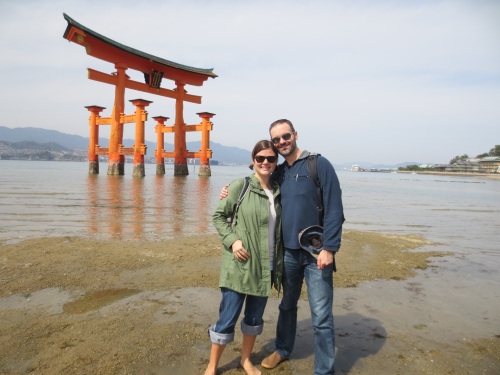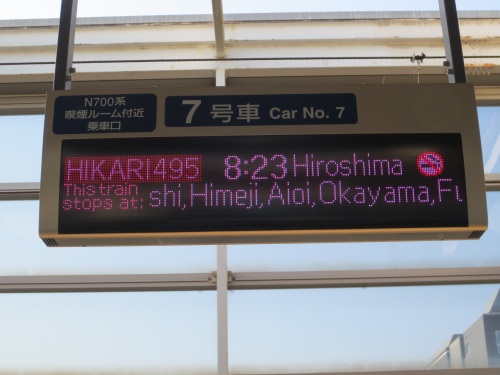Finally, some more photos from our Japan trip a month ago.
We took one day in Kyoto to do a day-trip to Hiroshima. It’s a bit of a ride, but a couple hours on the shinkansen (bullet train) is no big deal.
Hiroshima means pretty much one thing to most Americans, but it’s also a really cool city in its own right. They have an awesome public transportation system of trams that they call a “Working Museum.” Its fleet is composed of trains of all kinds manufactured in Europe and Asia during the past half century. So you’ll be on a relatively modern, 1980s train, chugging down the street, and see a ca. 1950 train waiting at the intersection.
I didn’t get a good photo of that juxtaposition, but you can bet that some Wikipedia author did:

It was helpful but a little bit off-putting that there are so many guide signs in the Hiroshima train station and tram station telling visitors how to get to the A-Bomb Dome. But that’s where nearly everyone, including us, was headed, so we made use of them. About 15 minutes later, we were here.
This is one of the few buildings to survive the blast, all the more remarkable given that the hypocenter—i.e., the spot on the ground directly below where the bomb exploded— is just a couple hundred yards away, on an otherwise unremarkable side street. It’s marked by this small plaque.
Peace Memorial Park is a lovely place (and all the more lovely when we were there because the weather was beautiful and the cherry blossoms in bloom). This is the cenotaph in the park. As you can see, it’s in a perfect line with the A-Bomb Dome and the Memorial Museum (behind where I’m standing to take this photo). It contains the names of all of the dead, and bears the inscription “Let all the souls here rest in peace for we shall not repeat the evil.”
Many of the memorials are decorated with bright-colored strands that, from a distance, look like woven threads. They’re actually made of thousands of origami cranes. These are tied to the story of Sadako Sasaki, who died of leukemia 10 years after the bombing, and who believed—following a Japanese legend—that folding a thousand paper cranes would grant her her wish to get better. People are still folding cranes today.
Especially moving was the Peace Memorial Hall. The main hall is circular, and shows the skyline of Hiroshima. On the wall are the neighborhoods affected by the blast. We were the only two people there, and the water bubbling from the fountain in the middle made for an oddly serene experience.
Here’s what the fountains looks like close up.
If you’re wondering what that means, look at this object from the museum:
The fountain represents a clock stopped at 8:15am, the time of the explosion.
We also took a half-day trip from our day-trip. From Peace Memorial Park, you can take a 45-minute ferry ride to Miyajima.
A view from the ferry approaching the island. The famous orange torii is just visible near the lower left.
Miyajima is famous for two things: cheeky deer and the floating torii.
The deer roam all over the island. They are incredibly un-skittish, almost certainly because people feed them all the time.
And why wouldn’t you feed them? They’re so cute.
You just pull out a cracker and hand it over. Here you go, buddy. Isn’t this nice?
But then the deer, who has led a privileged life and thus has a deep sense of entitlement, wants more. And then the deer’s colleagues, fruitlessly harassing someone else, get wind of the jackpot that’s being dispensed to their friend and mosey on over to join.
And that’s how you end up with a couple of deer snouts in your snack container. And no snacks.
But there are other things to see besides the deer. (Though since there are a good number of deer and the island is pretty small, all of the sites are quite literally beside the deer, viz.:)

At high tide, the water covers the area where we’re standing, as well as the bottom of the torii, hence it is sometimes called the “floating torii.”
As you will have gathered, the torii is one of the most photographed sights in Japan. If I were an MFA photography student, my thesis project would be photographs of people taking photographs of famous touristy sites. Like so:
After about 90 minutes on Miyajima—during which we fed one of the resident deer the remainder of a soft-serve ice cream, paper cone wrapper included, and witnessed another deer try to eat a woman’s flannel shirt—we headed back to Hiroshima for dinner, then back to Kyoto.






















http://www.youtube.com/watch?v=3arHcXSQRsM This song is now in my head.